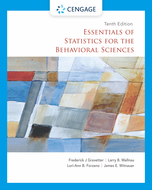Solution Found!
?As noted on page 332, when the two population means are equal, the estimated standard
Chapter 10, Problem 20(choose chapter or problem)
As noted on page 332, when the two population means are equal, the estimated standard error for the independent-measures t test provides a measure of how much difference to expect between two sample means. For each of the following situations, assume that \(\mu_{1}=\mu_{2}\) and calculate how much difference should be expected between the two sample means.
a. One sample has \(n=6\) scores with \(S S=500\) and the second sample has \(n=12\) scores with \(S S=524\).
b. One sample has \(n=6\) scores with \(S S=600\) and the second sample has \(n=12\) scores with \(S S=696\).
c. In Part b, the samples have larger variability (bigger SS values) than in Part a, but the sample sizes are unchanged. How does larger variability affect the magnitude of the standard error for the sample mean difference?
Questions & Answers
(1 Reviews)
QUESTION:
As noted on page 332, when the two population means are equal, the estimated standard error for the independent-measures t test provides a measure of how much difference to expect between two sample means. For each of the following situations, assume that \(\mu_{1}=\mu_{2}\) and calculate how much difference should be expected between the two sample means.
a. One sample has \(n=6\) scores with \(S S=500\) and the second sample has \(n=12\) scores with \(S S=524\).
b. One sample has \(n=6\) scores with \(S S=600\) and the second sample has \(n=12\) scores with \(S S=696\).
c. In Part b, the samples have larger variability (bigger SS values) than in Part a, but the sample sizes are unchanged. How does larger variability affect the magnitude of the standard error for the sample mean difference?
ANSWER:Step 1 of 4
(a)
Let the null hypothesis be \(H_{0}: \mu_{1}=\mu_{2}\)
Let the sum of squares of the first sample be \(S S_{1}=500\)
Let the number of observations in a first sample be \(n_{1}=6\)
The degrees of freedom for first sample is,
\(\begin{array}{l}
d f_{1}=n_{1}-1 \\
=6-1 \\
=5
\end{array}\)
Reviews
Review this written solution for 1075700) viewed: 128 isbn: 9780357365298 | Essentials Of Statistics For The Behavioral Sciences - 10 Edition - Chapter 10 - Problem 20
Thank you for your recent purchase on StudySoup. We invite you to provide a review below, and help us create a better product.
No thanks, I don't want to help other students
